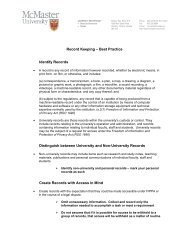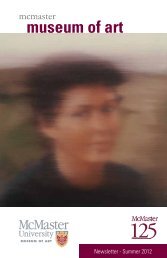Pilgrimage: A Paradigm for Spiritual Formation - McMaster University
Pilgrimage: A Paradigm for Spiritual Formation - McMaster University
Pilgrimage: A Paradigm for Spiritual Formation - McMaster University
You also want an ePaper? Increase the reach of your titles
YUMPU automatically turns print PDFs into web optimized ePapers that Google loves.
140<br />
<strong>McMaster</strong> Journal of Theology and Ministry 12<br />
mysterious and intricate. Craig Bartholomew notes that,<br />
conceptually, a pilgrimage “can be thought of as a micro-journey<br />
by means of which one explores the macro-journey of one’s life .<br />
. . It is vital that this connection with the whole of life is present<br />
in pilgrimage: the journey in . . . becomes the foundation <strong>for</strong> the<br />
journey out. And this should be true not just at a personal level<br />
but at a communal and societal one too [italics original].” 18<br />
Following the biblical concepts of pilgrimage, in early<br />
Christian tradition believers made pilgrimages to sacred sites <strong>for</strong><br />
various reasons such as devotion or penance. However, due to<br />
distortions and abuses of the biblical precedents, particularly<br />
during the Middle Ages, pilgrimage came under censure in the<br />
Re<strong>for</strong>mation. It is not possible here to trace and engage with that<br />
history, but Dee Dyas finds some significant principles within<br />
medieval patterns of pilgrimage that are helpful <strong>for</strong> the purposes<br />
of developing a paradigm <strong>for</strong> spiritual <strong>for</strong>mation.<br />
First, the medieval church held one over-arching theological<br />
concept that Dyas terms as “life pilgrimage,” together with three<br />
strands of practical interpretation that she classifies as “place<br />
pilgrimage,” “moral pilgrimage,” and “interior pilgrimage.”<br />
Place pilgrimage focused on mobility, shrines, saints, relics,<br />
indulgences, danger, and temptation. Moral pilgrimage emphasized<br />
stability, calling, obedience, responsibility, community,<br />
service, and love. The interior pilgrimage was characterized in<br />
the monastic movement by stability, withdrawal/solitude,<br />
prayer/meditation, encounters with God, visions, and anticipation<br />
of heaven. Within this concept of life pilgrimage, one can<br />
observe both external and internal dimensions. To summarize,<br />
Dyas contends that “[t]he central, non-negotiable expression of<br />
life pilgrimage was to live in daily obedience to God in the place<br />
of one’s calling, resisting sin and serving others” 21 in whatever<br />
context one found oneself. Christian mystics such as Teresa of<br />
Avila and John of the Cross, embodied this perspective when<br />
18. Bartholomew, “Journeying On,” 209.<br />
19. Dyas, “Medieval Patterns,” 92–109.<br />
20. Ibid., 97. Dyas delineates these three dimensions on pp. 98–101.<br />
21. Ibid., 98.<br />
19<br />
20
















